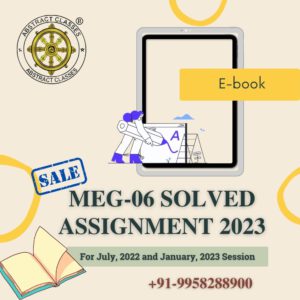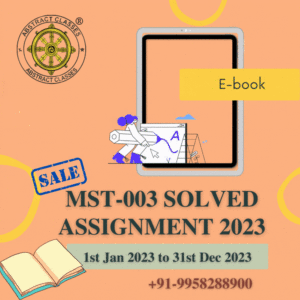
IGNOU BCHET-147 Solved Assignment 2024 | B.Sc. CBCS Chemistry
₹49.00
Please read the following points before ordering this IGNOU Assignment Solution.
Share with your Friends
IGNOU BCHET-147 Assignment Question Paper 2024
bchet-147-solved-assignment-2024-qp-2a3389b2-3897-43a5-b031-cd4fac7cc278
(i) carbonylate anion by addition of alkali or reduction (any two)
(ii) carbonyl hydrides (any one)
(iii) carbonyls by displacement of
11 Discuss the preparation of the following compounds starting from ethyl 3oxobutanoate?
i) 2-Butenoic acid (crotonic acid)
ii) 4-ketopentanoic acid

BCHET-147 Sample Solution 2024
bchet-147-solved-assignment-2024-ss-8e24e610-06c9-4b43-84f6-a5bf6ef5ab5c
Detection of Sulfide Ions (S^(2-) S^{2-}
Detection of Elemental Sulfur (S S
1. Composition:
- Organometallic Compounds: These compounds contain at least one metal-carbon bond (M-C) where the metal is typically a transition metal, a lanthanide, or an actinide. The metal can be in a low oxidation state and can form complexes with organic ligands.
- Organic Compounds: Organic compounds are primarily made of carbon and hydrogen atoms, and they may also contain other non-metal elements such as oxygen, nitrogen, sulfur, and halogens. There are no metal-carbon bonds in most organic compounds.
2. Bonding:
- Organometallic Compounds: The metal-carbon bond in organometallic compounds can exhibit both ionic and covalent character, depending on the nature of the metal and the organic group. The bonding involves the interaction of the metal’s d orbitals with the carbon’s sp³, sp², or sp orbitals.
- Organic Compounds: The bonding in organic compounds is predominantly covalent, involving the sharing of electrons between atoms. The carbon atoms typically form sp³, sp², or sp hybridized orbitals.
3. Reactivity:
- Organometallic Compounds: Organometallic compounds are often highly reactive, especially towards air, moisture, and acids, due to the polar nature of the metal-carbon bond. They are commonly used as catalysts in various chemical reactions, such as cross-coupling reactions and olefin metathesis.
- Organic Compounds: The reactivity of organic compounds varies widely depending on their functional groups and structure. They can undergo a range of reactions, including substitution, addition, elimination, and rearrangement reactions.
4. Applications:
- Organometallic Compounds: These compounds are extensively used in catalysis, both in industrial processes and in laboratory synthesis. They are also employed in the development of new materials, as well as in organic light-emitting diodes (OLEDs) and other electronic applications.
- Organic Compounds: Organic compounds have a wide range of applications in pharmaceuticals, plastics, fuels, dyes, agrochemicals, and many other industries.
5. Examples:
- Organometallic Compounds: Ferrocene (Fe(C₅H₅)₂), Grignard reagents (RMgX, where R is an alkyl or aryl group and X is a halogen), and Wilkinson’s catalyst (RhCl(PPh₃)₃).
- Organic Compounds: Methane (CH₄), benzene (C₆H₆), ethanol (C₂H₅OH), and acetic acid (CH₃COOH).
Frequently Asked Questions (FAQs)
You can access the Complete Solution through our app, which can be downloaded using this link:
Simply click “Install” to download and install the app, and then follow the instructions to purchase the required assignment solution. Currently, the app is only available for Android devices. We are working on making the app available for iOS in the future, but it is not currently available for iOS devices.
Yes, It is Complete Solution, a comprehensive solution to the assignments for IGNOU. Valid from January 1, 2023 to December 31, 2023.
Yes, the Complete Solution is aligned with the IGNOU requirements and has been solved accordingly.
Yes, the Complete Solution is guaranteed to be error-free.The solutions are thoroughly researched and verified by subject matter experts to ensure their accuracy.
As of now, you have access to the Complete Solution for a period of 6 months after the date of purchase, which is sufficient to complete the assignment. However, we can extend the access period upon request. You can access the solution anytime through our app.
The app provides complete solutions for all assignment questions. If you still need help, you can contact the support team for assistance at Whatsapp +91-9958288900
No, access to the educational materials is limited to one device only, where you have first logged in. Logging in on multiple devices is not allowed and may result in the revocation of access to the educational materials.
Payments can be made through various secure online payment methods available in the app.Your payment information is protected with industry-standard security measures to ensure its confidentiality and safety. You will receive a receipt for your payment through email or within the app, depending on your preference.
The instructions for formatting your assignments are detailed in the Assignment Booklet, which includes details on paper size, margins, precision, and submission requirements. It is important to strictly follow these instructions to facilitate evaluation and avoid delays.
Terms and Conditions
- The educational materials provided in the app are the sole property of the app owner and are protected by copyright laws.
- Reproduction, distribution, or sale of the educational materials without prior written consent from the app owner is strictly prohibited and may result in legal consequences.
- Any attempt to modify, alter, or use the educational materials for commercial purposes is strictly prohibited.
- The app owner reserves the right to revoke access to the educational materials at any time without notice for any violation of these terms and conditions.
- The app owner is not responsible for any damages or losses resulting from the use of the educational materials.
- The app owner reserves the right to modify these terms and conditions at any time without notice.
- By accessing and using the app, you agree to abide by these terms and conditions.
- Access to the educational materials is limited to one device only. Logging in to the app on multiple devices is not allowed and may result in the revocation of access to the educational materials.
Our educational materials are solely available on our website and application only. Users and students can report the dealing or selling of the copied version of our educational materials by any third party at our email address (abstract4math@gmail.com) or mobile no. (+91-9958288900).
In return, such users/students can expect free our educational materials/assignments and other benefits as a bonafide gesture which will be completely dependent upon our discretion.
Related products
-
IGNOU Assignment Solution
IGNOU MEG-11 Solved Assignment 2022-2023 | MEG | AMERICAN NOVEL
₹101.00 Go to the App -
IGNOU Assignment Solution
IGNOU MEG-06 Solved Assignment 2022-2023 | MEG | AMERICAN LITERATURE
₹101.00 Go to the App




